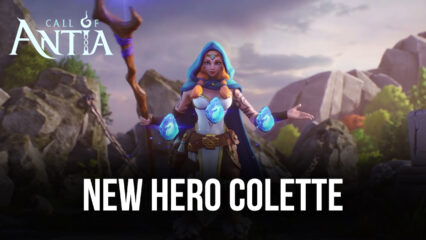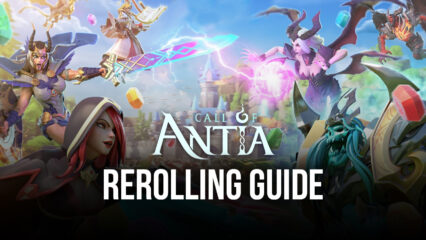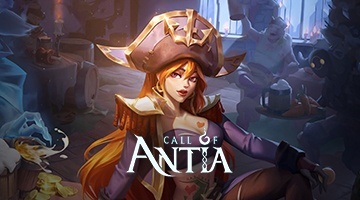Beginner’s Guide for Call of Antia - Tips and Tricks for New Players
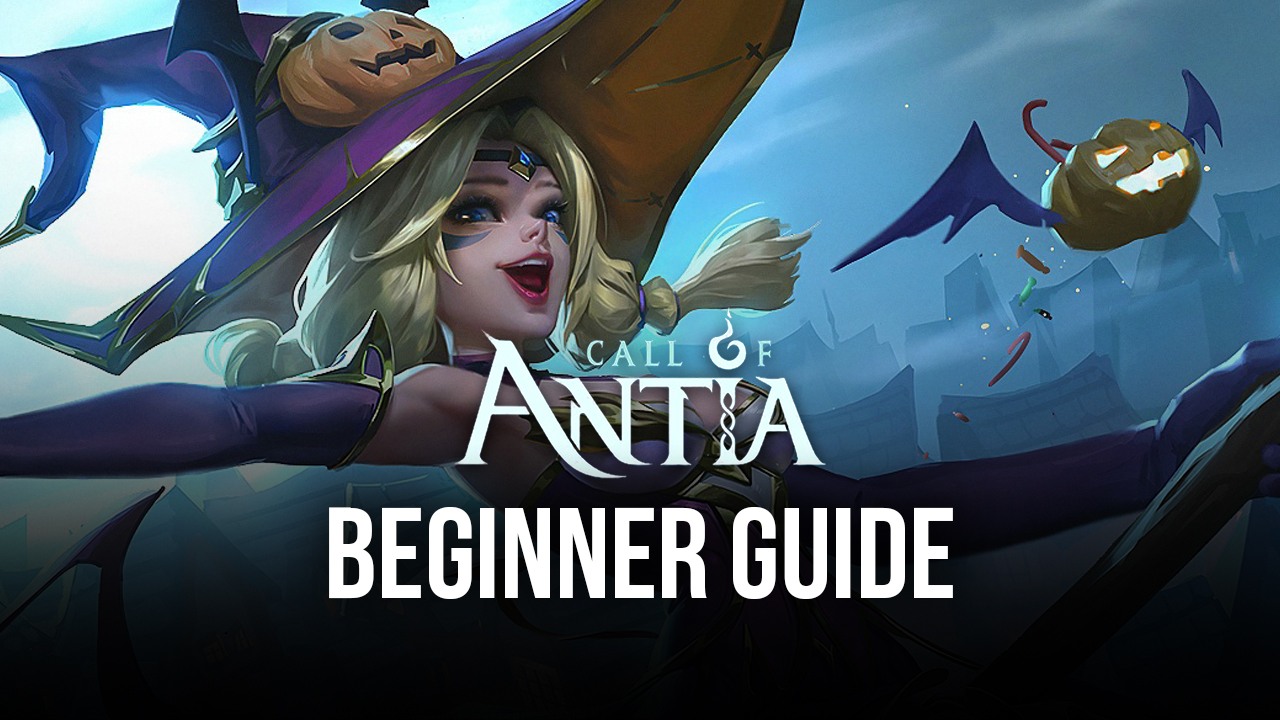
Call of Antia is an interesting game that marries many defining elements of a variety of genres and creates a unique hybrid of features that offer the simplicity of match-3 titles, the complexity of RPGs, and the grinding of gacha games. With this combination of aspects, it’s understandable that some players might be confused about how to begin. In this sense, if you’re just starting out, then this article is for you.
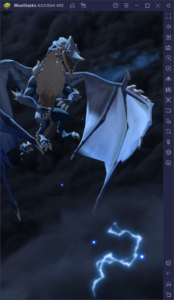
In this beginner’s guide for Call of Antia, you’ll find a brief overview of some of the basic aspects in this game, so that you can start on the right track.
Combat System Basics
The combat in Call of Antia is actually one of the easiest and most interesting aspects since it consists mostly of match-3 fights against waves of enemies. The way this works is that every time you combine three or more tiles, these will turn into projectiles that shoot straight up at the enemies. In this sense, the idea is to combine enough tiles to deal sufficient damage and defeat the enemy team.
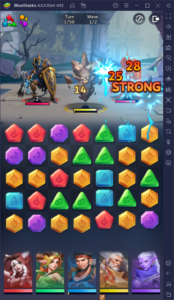
However, the enemy isn’t idle while you’re matching tiles, as every move you make will cause them to act and attack in retaliation. And just like your enemies can fall, your units can also be defeated if they take enough damage. Consequently, fights are about unleashing powerful combos and chain reactions in order to deal tons of damage to the enemy team, and defeat them before they can do the same to you.
To help in combat, your units can use powerful active skills, which are charged up every time you create combos with tiles of the same color. Once a skill is charged and ready, you can click on your characters’ portraits to unleash it. Some of these skills can turn the tide of battle if used correctly, so it’s important to know what they do in order to get the most out of them.
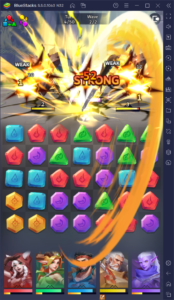
One last thing to note about the battle system is that, whenever you attack an enemy by combining three or more tiles, the projectiles originate from the place where you create the combo. In this sense, if you unleash a combo on the far right of the board, your attacks will only hit the enemies directly above. Because of this, it’s possible to entirely miss a target if you create a combo in a place where there are no enemies.
As a general rule of thumb, to do maximum damage to a single enemy, vertical combinations are your best bet. Conversely, if you want to hit multiple enemies in a single move, horizontal combos will be your bread and butter. And lastly, since your skills are often quite powerful, it’s always worth going out of your way to set up chain reactions and unleash longer combos, which will help to quickly charge your skills.
Elemental Matchups
Just like in other match-3 games, the tiles in Call of Antia come in many different colors; five of them, to be exact. These colors represent the different elements in the game. Similarly, your characters also come in five different colors that represent their elemental affinities. In this manner, whenever you create a combination on the board, only the characters with the corresponding color will attack, and only they will receive a charge for their acting skills.
The most important part of the elemental system, however, is the fact that every element is strong against one and weak against another. The way these elements interact is the following:
- Red defeats Green
- Green defeats Blue
- Blue defeats Red
- Purple and Yellow are opposites and deal additional damage to each other, and don’t interact with the others.
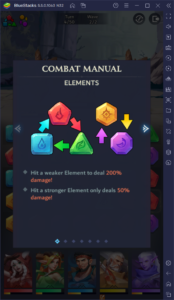
With that being said, in order to keep up your offense, you should only try to make combinations with tiles corresponding to the elements of the characters in your team. For instance, if you combine three blue tiles, but have no blue heroes, then nothing will happen and you will have lost a turn. This brings us to our next point…
Team Formation Tips
Call of Antia is an RPG, which means that there are several considerations to be had when creating your formations.
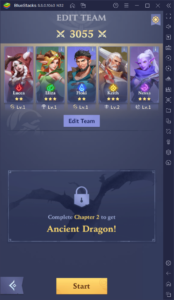
Your team can only include a maximum of five heroes, so it’s important to consider your synergy when choosing your units. However, more importantly, than this synergy is the combination of colors you include in your squad:
For instance, if you take a character of each color, then every single tile combination will result in successful attacks. However, you could also go for risky formations and include multiple characters of the same element in your team. In this manner, whenever you combine their specific color, you’ll unleash numerous attacks at the same time, effectively multiplying your damage, and charging up the skills of all the units that attacked. The obvious tradeoff here is that, whenever you combine an element that you don’t have, you’ll effectively lose a turn.
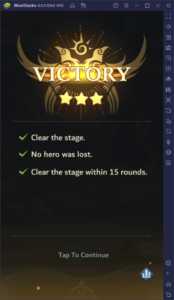
With that being said, depending on the stage, you could focus your team on a single element to target the enemy’s weaknesses or spread your team across all five to ensure that you always get an attack. For general use, however, we always recommend the latter as this will ensure that you’re rocking a balanced formation that can effectively face any challenge. Use focused formations only when you’re having trouble with specific stages, as the boost in attack can help you defeat some of the tougher bosses. If you’re lucky enough to get the right tiles on the board, that is.
City Building and Development
Call of Antia, despite being mostly a match-3 game with gacha RPG elements, also incorporates some idle gameplay mechanics into the mix, just to give players an extra push by allowing them to continue producing resources while offline. These elements come in the form of a basic city building mechanic in the home screen, where you can build and develop a series of buildings to give you several advantages.
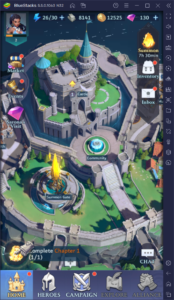
Just like in conquest games like Rise of Kingdoms, State of Survival, or others, you get access to your very own city in Call of Antia, though admittedly it’s a very basic version, consisting only of a handful of buildings. Nevertheless, in your base, you can construct a variety of structures that generate resources, such as camps (experience potions), quarries (stone), and mines (gold). These structures are governed by your central building, the Castle, which can be upgraded to unlock more lots for production structures. Similarly, your production facilities can also be upgraded to increase their hourly generation.
It’s important to point out here that there’s a unique building called the “house” that, while it doesn’t produce resources, allows you to send your heroes on missions. These missions take a set amount of time to complete, after which your heroes will come back with several rewards including hero experience, gold, and more. Moreover, instead of granting more resources per hour when upgraded, enhancing the house unlocks missions of higher star ratings, which in turn grant better rewards upon completion.
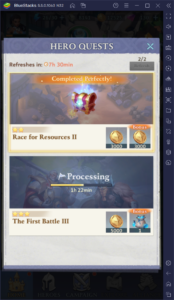
Keep in mind that, when it comes to the house, the heroes you send out on quests aren’t actually removed from your team, and you can still deploy them in combat even when they’re assigned to a mission. In this sense, the house is basically a free way to earn resources, just like the other buildings, but only as long as you remember to always send your units out on quests.
By keeping your buildings upgraded, always sending your units on missions, and creating effective team formations, you can progress easily and quickly in Call of Antia. And if you reroll and unlock powerful characters from the beginning, you’ll get a good head start as these can carry you through the initial missions.
Feel free to check out our BlueStacks setup guide for this title to learn how to set up this game on your PC. By playing Call of Antia on your computer, you not only will be able to enjoy it on a much larger monitor and appreciate every little visual detail, but you’ll also gain access to a variety of tools that can further improve your experience with this game, including the Instance Manager, through which you can reroll on multiple instances at the same time, potentially letting you unlock powerful characters much faster.
Feel free to leave your own comments and beginner tips in the comments below to help out your fellow readers. Furthermore, we also encourage you to leave any questions or concerns below, and we’ll get back to you ASAP.


